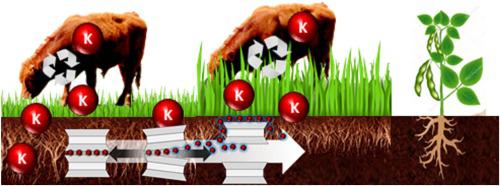Soil and Tillage Research ( IF 6.5 ) Pub Date : 2020-11-19 , DOI: 10.1016/j.still.2020.104864 Tauana Ferreira Almeida , Jacques Krticka Carvalho , Elise Reid , Amanda Posselt Martins , Carlos Alberto Bissani , Edson Campanhola Bortoluzzi , Gustavo Brunetto , Ibanor Anghinoni , Paulo César de Faccio Carvalho , Tales Tiecher

|
The presence of animal grazing at different intensities in integrated crop livestock systems (ICLS) may affect the forms and the balance of K in the soil, especially after many years. The objective of this study was to evaluate different K forms and their balance for 17 years with ICLS. ICLS experimental area used no-till practices with different grazing intensities of cattle in winter pasture (black oat + annual ryegrass) and soybean production in the summer season. The experiment started in May 2001 at a location with a Rhodic Hapludox (Oxisol). The treatments consisted of varied grazing intensities: intensive grazing (IG) at 10 cm of pasture height, moderate grazing (MG) at 20 cm of pasture height, and a no grazing (NG) treatment. The experimental design was a randomized block design with three replicates. Soil samples were collected in 2001, 2007, 2012 and 2017 in 0−5, 5−10, 10−15 and 15−20 cm of soil layers. Desorption of K was measured using the Mehlich-1 method and the results were fitted to first-order kinetic equations to obtain readily and potentially available K content. Total K was determined by X-ray fluorescence, and the unavailable K by the difference between the total K and potentially available K. Long-term no-till ICLS resulted in an increase in more readily available K forms in the soil surface. The increase was especially prominent in the no-grazing treatment due to the greater amount of K left in the plant residues. Regardless of grazing intensity, soybean cultivation was the controlling component of the soil nutrient budget, representing 98.6 % of the total amount of K exported. Animal outputs represent only 1.4 % of total K exported and are therefore the recycling component of the system. Although meat production in ICLS represents only a very small fraction of the amount of K exported from the system, K tends to become less available in the grazed treatments in the long-term.
中文翻译:

亚热带大气长期混合农作物系统中土壤钾的形态和平衡
综合耕种牲畜系统(ICLS)中不同强度放牧的动物的存在可能会影响土壤中钾的形态和平衡,尤其是在多年之后。这项研究的目的是使用ICLS评估17年中不同的K形式及其平衡。ICLS试验区采用免耕措施,冬季牧场(黑燕麦+年生黑麦草)的牛放牧强度不同,夏季则种植大豆。该实验于2001年5月在Rhodic Hapludox(Oxisol)的位置开始。处理方法包括不同的放牧强度:在牧场高度10 cm时进行密集放牧(IG),在牧场高度20 cm处进行中度放牧(MG),以及不放牧(NG)。实验设计是具有三个重复的随机区组设计。2001年收集了土壤样本,2007、2012和2017年在0-5、5-10、10-15和15-20厘米的土层中。使用Mehlich-1方法测量K的解吸量,并将结果拟合至一阶动力学方程式,以获取容易和潜在可用的K含量。总钾由X射线荧光测定,而无效钾则由总钾与潜在有效钾之间的差值确定。长期免耕ICLS导致土壤表面更易于利用的钾形态增加。由于植物残渣中残留的钾含量更高,因此在非放牧处理中这种增加尤为明显。无论放牧强度如何,大豆种植都是土壤养分预算的控制部分,占钾素出口总量的98.6%。动物输出仅代表1。出口的K总量的4%,因此是系统的回收组件。尽管ICLS中的肉类生产仅占系统输出的K量的很小一部分,但从长期来看,放牧处理中K的可用性往往会下降。



























 京公网安备 11010802027423号
京公网安备 11010802027423号